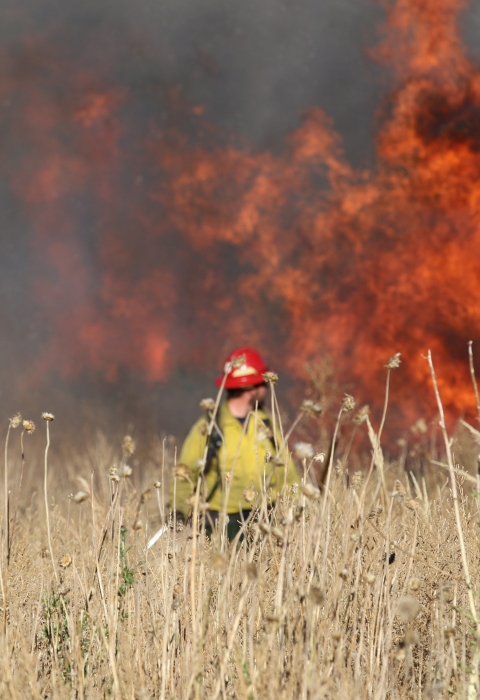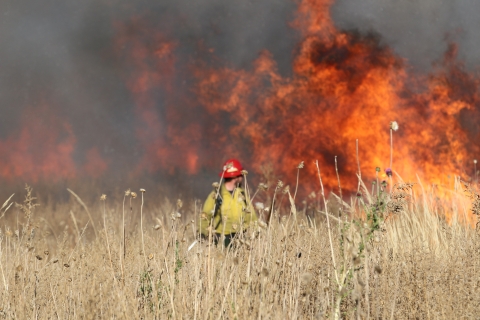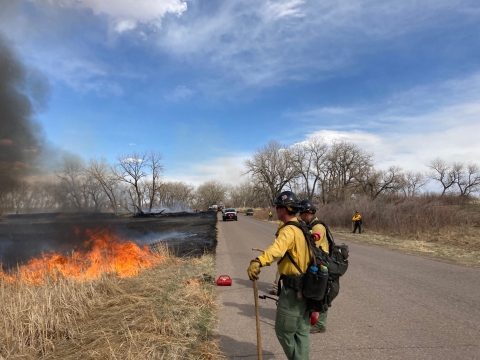The Fire Makes a Home
From the foothills of the Rocky Mountains and east towards Indiana, lies the unique prairie ecosystem. This landscape is home to a diverse array of wildlife including bison, hawks, eagles, warblers, finches, amphibians, fish, and hundreds of plants. But what’s also special about the prairie ecosystem is its resiliency, which means an ability to withstand sudden changes.
Fire is one such essential change and the grasses of prairie ecosystems are adapted to wildfires. When lightning strikes in grassland ecosystems, it can ignite the land and burn away the vegetation. Underneath the burn layer, the grasses persist through their root systems. The parts of grasses that are vital to their survival are underground and safe from the fire, like how a prairie dog burrows underground to stay safe from a hawk.
The fire cycle then creates a landscape that has benefits for the wildlife that live there. Nutrients, like the carbon left over from burnt plant matter, go back into the soil giving it the right ingredients to generate rich and healthy plants again. Fresh grass and flowering plants begin to grow soon after, which become food for wildlife and structure for ground nesting birds building their homes.
This cycle of regrowth is crucial for grazing animals like bison and deer as well as for pollinators too. The fresh vegetation can also be home to small insects, rodents, and snakes.
A Burn with a Benefit
Rocky Mountain Arsenal National Wildlife Refuges (RMA) practices prescribed burns to replicate this natural cycle. Every year, different sections of the Refuge are intentionally burned so that most of the area will have been burned every six to seven years. These practices allow for sustainable, healthy soils that provide the foundation for life on the prairie.
Management decisions take place every day on how to optimize the health of the land at RMA. Some sections of the land are burned intentionally, but there is also a need to protect other sections from fire so that there is enough unburned area to provide continuous food and shelter for animals, insects, birds, rodents, and reptiles/amphibians. As a fire mitigation plan, sections of the Refuge are mowed to shorten the length of grasses and thus reduce potential wildfire risk.
Stoked for the Future of Fire
Wildland fire management received a big boost due to funding from the Bipartisan Infrastructure Law. Signed into effect in 2021, one facet of this law is to help deliver funding to communities across the country to prepare for and respond to wildfires.
At RMA, these funds were used to hire a team through the American Conservation Experiences to help with managing “fire fuels” on the Refuge. The team works diligently to clear dead trees, thick “duff” vegetation, and invasive plants that increase wildfire danger. The work helps decrease the intensity of fires and reduces their ability to spread.
These new opportunities are crucial to advancing critical infrastructure and fire response, and ultimately conserving and restoring habitat for the benefit of wildlife and people.
Additional Resources
- To learn more about how the Bipartisan Infrastructure Law is helping with wildfire mitigation and resiliency across the country
- To learn more about the Rocky Mountain Arsenal National Wildlife Refuge
About the Author:
Trevor Tompkins is from San Diego, CA. Trevor joined the RMA to fulfill his dream of working in conservation. He is deeply inspired to protect biodiversity and aims to work in a variety of different ecosystems learning about different methods of conservation. In 2022, Trevor worked as a research assistant at San Diego State University’s marine ecology lab assessing the restoration success of the Olympia oyster (Ostrea lurida) in Newport Bay and intends to explore more research opportunities in the future. Outside of work Trevor enjoys playing music, watching movies, and exploring new places and restaurants.








